Do you live in regional Queensland? Do you think your only choice of electricity retailer is Ergon Energy? Then I have exciting news for you. You can choose who bills you for electricity.
This is not a new thing. But many people aren’t aware of it. Until recently, this included me and — after talking to my father — I’ve discovered it includes people who have been living there longer than I’ve been alive.
Luckily I’m a fast learner, and I can now tell you all about:
- What retailers you can choose from in regional Queensland.
- How much money — if any — you’re likely to save by switching to them.
Most homes won’t be able to save much by changing retailers, but switching is easy, so it can be worthwhile — provided you don’t get screwed over by your new electricity retailer.
This is a reasonable concern because electricity retailers have been known to screw over their customers at least once or twice in Australia’s history.
Regional Queensland Is The Ergon Energy Area
By regional Queensland, I specifically mean the Ergon network area. It covers Toowoomba and everything west and Kilkivan and everything north. Here’s a map:
Ergon is the Distributed Network Service Provider or DNSP in this area. This means they’re in charge of the local poles, power lines, and substations that provide power to farms, homes, and businesses.
Ergon Energy is also an electricity retailer. This means they…
- Read meters.
- Send people their electricity bills.
- Offer electricity plans, and…
- Answer customer questions.
For a long time, they were the only retailer in regional Queensland, but since 2007 other retailers have been allowed to operate in the area.
It’s Almost A Secret
I was surprised to learn that retailer choice existed in the Ergon area. However, I think you can excuse my ignorance because I don’t live there. But my parents have lived in the Ergon area for longer than I’ve been alive, and they also didn’t know. None of their friends apparently knew about it either.
Well, one of their friends said he knew, but he also claims to have wrestled Idi Amin to stop him feeding a child to a crocodile, so take that with a bucket of salt.

“I have never met the man. We have certainly never wrestled. But if we did, I would have won.” (Image: Associated Press)
When I spoke to one of the retailers on the phone, they practically begged me to tell my friends and relatives about them. So it looks like the problem may be regional Queensland-wide and not just that my parents happen to live in the middle of Thicktopia.
Ergon Retailing No Longer Being Phased Out
When regional Queensland introduced retailer choice, a rule prohibited people from returning to Ergon Energy if they ever left. This reduced the number of people switching. The possibility of returning to Ergon’s warm, reassuring clutches gave comfort. After all, retailer choice had often turned out to be less-than-wonderful in other places.
Fortunately, since 2018, people can return to Ergon1 if they try a different retailer, switching carries less risk these days.
A SolarQuotes Tool (Not Me!)
Discovering which local electricity retailers offer the lowest cost plan is tedious. At least it is if you don’t use the SolarQuotes Electricity Retailer comparison tool. With that, it’s easy. You can also use the Government Energy Made Easy comparison site, but it’s not as good. The SolarQuotes one is designed for solar homes, and I know it cost a hell of a lot less to make than the government one.
To use our comparison tool, you enter your…
- Solar power system size and…
- Postcode
Into boxes that look exactly like this:
After entering your postcode, two sliders appear set at typical values for your location and solar system size. They are for…
- Solar energy self-consumption — the percentage of solar generation your home consumes itself.
- Total electrical energy use per day — a combination of grid and solar electricity consumption.
You can change the value of these sliders, and this is what they look like:
Below these, you’ll see retailer plans in order from cheapest to most expensive. Here’s what they look like for Bundaberg, postcode 4670, for an 8 kilowatt solar home with the sliders at their default values:
There are 5 different retailers in Bundaberg, and the first four plans give our 8 kilowatt home an annual credit. The lowest cost plan is from LPE. They’ll be the cheapest for the majority of solar homes in regional Queensland.
SQ Retailer Comparison Tool Advanced Option
You can also click on a box that says “Advanced” to get a more accurate result:
This will let you enter the following details from your electricity bills:
- Billing period
- kWh imported — How many kilowatt-hours of grid electricity your home used.
- kWh exported — How many kilowatt-hours of solar electricity your home sent into the grid for a feed-in tariff.
This will give a precise answer to which retail plan will be the cheapest, but the simple option will almost always give the right answer.
Our Comparison Tool Is A Work In Progress
The SQ Retailer Comparison Tool is still under development and runs on the smell of an oily rag. We can’t be completely certain the results it gives will be correct for every single plan, as it notes here:
As I will explain below, I have discovered it gives an incorrect result for people using a Globird Energy standard tariff if they consume more than 487 kilowatt-hours a month. But, because I went to all the retailer sites to check the other results, I’m confident they’re right.
We will fix the problem with the Globird plan and make sure it gives the correct result, but I’m not sure how long that will take because I don’t know the first thing about programming. I can’t even program my VCR. I still have a VCR, which is probably a good indicator I don’t have enough technical ability to program anything.
If our tool gives any other incorrect or odd results please let us know, and we’ll get it fixed by someone who doesn’t think that a USB port is on the coast of the United States of Brazil.
5 Regional QLD Retailers
There are five electricity retailers in regional Queensland:
- Ergon Energy
- LPE — Short for Locality Planning Energy, so no wonder they go by the abbreviation…
- Bright Spark Power
- QEnergy
- Glowbird Energy
There may be others that do a damn good job of hiding because I haven’t been able to find them.
Ergon is available everywhere. Availability of the others depends on location.
Little Choice For Some
This Ergon page says retailer choice isn’t available in the following places:
But it appears to be out of date because both LPE and Globird Energy claim to be in Mount Isa. But if you are on a tiny microgrid without any electrical connection to the rest of Queensland, you’re not going to have a choice.
Most people in regional Queensland get to choose between 4 or 5 electricity retailers.
Retailer Plan Details
I’ve put the details of the retailers most commonly used plans below. These are for flat tariffs — also known as standard tariffs — which charge the same flat rate for every kilowatt-hour used. People with smart meters also have the option of getting a time-of-use tariff or a demand tariff, but most solar homes are better off with a standard tariff. (But solar homes with a battery can be better off with a time-of-use or a demand tariff.)
Ergon Energy: By far the most common retailer in regional Queensland
- Daily supply charge: 99.74 cents.
- Per kilowatt-hour charge: 23.93 cents
- Solar feed-in tariff: 7.86 cents
LPE: Very similar to Ergon but slightly cheaper, so you’ll always save a little by switching from Ergon to LPE.
- Daily supply charge: 99.66 cents
- Per kilowatt-hour charge: 23.09 cents
- Solar feed-in tariff: 7.865 cents
Globird Energy: The per kilowatt-hour charge has two rates depending on how much has been used in the month2. It also has the highest supply charge.
- Daily supply charge: $1.76
- Per kilowatt-hour charge: First 486.67 per month are 17.82 cents each. Each additional kilowatt-hour is 23.1 cents
- Solar feed-in tariff: 7.861 cents
Bright Spark Power: This has a high supply charge but a low per kilowatt-hour charge.
- Daily supply charge: $1.70
- Per kilowatt-hour charge: 19.99 cents
- Solar feed-in tariff: 8 cents
QEnergy: At 5.5 cents, this retailer offers the lowest solar feed-in tariff by a significant margin.
- Daily supply charge: 99.73 cents
- Per kilowatt-hour charge: 23.93
- Solar feed-in tariff: 5.5 cents
Metering Charges
In addition to the daily supply charge and per kilowatt-hour charge, Queenslanders also have to pay metering fees separate from the daily supply charge. Here are Ergon’s daily metering fees:
- Home electricity meter fee: 11.381 cents
- Controlled load meter: 3.317 cents
- Solar metering: 4.455 cents (While solar energy exports are measured by your main household electricity meter, there is a separate charge for it.)
Fortunately, all retailer’s metering fees appear to be similar. The amounts charged for metering may change slightly on the 1st of July.
Lowest Cost Electricity Plans
I have used the SolarQuotes Electricity Retailer Comparison tool to find the lowest cost plans in regional Queensland. I’m sure the results are right because I doubled checked them by hand. (I was holding a calculator in my hand, but that still counts.)
To keep things simple, I’ll start by looking at the annual cost of electricity for a home with the following characteristics:
- A flat tariff.
- 5,000 kilowatt-hours of annual grid electricity consumption.
- 7,000 kilowatt-hours of annual solar exports. This is a typical amount for a home with a 6 kilowatt solar system.
- No controlled loads. (Also known as economy tariffs or off-peak hot water.)
While most solar homes use less than 5,000 kilowatt-hours of grid electricity per year, this won’t change which retailer has the cheapest plan. Using the above assumptions gives the following annual electricity bills with each retailer’s lowest-cost plan:
LPE is the winner coming out $40 a year cheaper than Ergon Energy. All others are more expensive than Ergon. With only modest savings available from changing away from Ergon, it’s not hard to see why there hasn’t been much interest in retailer choice in regional Queensland.
High Grid Consumption Homes
Which retailer has the lowest cost plan changes for homes with high grid consumption? If I keep all else the same but assume the home consumes 9,000 kilowatt-hours of grid electricity per year, then the annual bill for the different retailers becomes:
Globird Energy is the most expensive. Unfortunately — at the moment — our Retailer Comparison tool actually gives a different result and thinks it’s the cheapest. This is because it doesn’t recognize that Globird’s per kilowatt-hour charge increases after a home uses 468.67 kilowatt-hours in a month. This is enough to make Globird’s plan the worst for high grid consumption homes instead of the best. People who are better at herding ones and zeros than I am have been informed, and the problem will be fixed. But until we’re confident we’ve squashed all the bugs in it, please double-check the results from our comparison tool.
Bright Spark Power has the lowest cost plan for homes with high grid consumption because it has a high daily supply charge but a low per kilowatt-hour charge. This allows it to become the lowest-cost plan for homes that use around 8,000 kilowatt-hours of grid energy a year or more.
QEnergy’s Feed-in Tariff Is Low
Bright Spark Power has the highest solar feed-in tariff at 8 cents per kilowatt-hour, but this is only around 0.14 cents more than Ergon Energy, LPE, and Globird Energy. That’s not much of a difference. The solar feed-in tariff is almost identical for these four retailers.
The odd one out is QEnergy which only offers a feed-in tariff of 5.5 cents. This makes QEnergy a poor choice for solar households, and even households that export zero electricity to the grid will pay a little less with LPE.
Controlled Loads/Economy Tariffs
So far, I’ve assumed homes don’t use a control load. Controlled loads are also known as economy tariffs, off-peak tariffs, or off-peak hot water. They supply grid energy at a lower price but not for a full 24 hours a day. They are most commonly used for electric hot water systems.
There isn’t a large difference between retailer charges for controlled loads, so they won’t have much effect on which retailer is the cheapest for most households. Also, many solar households don’t have controlled loads because they are often better off shifting their electricity consumption to the day3.
There are two controlled load tariffs in Queensland:
- Tariff 31: This is available for a minimum of 8 hours a day. Ergon Energy says this is only suitable for large electric hot water systems with at least 250 litres capacity.
- Tariff 33: This is available for a minimum of 16 hours a day.
Retailers don’t control when devices on these tariffs get power or for how long. They can only change how much they charge for them. Unfortunately, QEnergy and Glowbird Energy give a price for a controlled load without telling if it’s tariff 31 or 33. I’ve put their published prices, in cents per kilowatt-hour, below:
- Ergon: Tariff 31 — 16.425 cents, Tariff 33 — 17.964 cents
- LPE: Tariff 31 — 16.42 cents, Tariff 33 — 17.96 cents
- Bright Spark Power: Tariff 31 — 16.42 cents, Tariff 33 — 17.96 cents
- QEnergy: 13.97 cents
- Globird Energy: 17.6 cents
Most homes use less than 10 kilowatt-hours of controlled load per day. My parent’s hot water system only averages 3 to 4 kilowatt-hours controlled load consumption each day. This is because regional Queensland tends to be warm. If the average consumed by a home is 5 kilowatt-hours per day then, over a year, the difference between QEnergy’s control load price and the highest price for Tariff 31 comes to $45. This is not nearly enough to put QEnergy in the lead for homes with solar power systems.
Prices Change In July
Electricity prices will change in July and are expected to fall more than 10%. Solar feed-in tariffs are also expected to fall. The most cost-effective retailer may change, but I expect them to keep their relative positions.
LPE Is The Winner For Most Solar Homes
For homes that consume 8,000 kilowatt-hours or of grid electricity per year or less, LPE provides the lowest-cost plan. Bright Spark Power is likely to be the cheapest for homes that use more grid electricity than this.
There is a narrow band of consumption where Glowbird energy may be slightly better than Bright Spark. Still, because electricity consumption varies throughout the year, households are unlikely to regularly hit that band each pay period, so I have no problem recommending LPE and Bright Spark over them.
Shifting away from Ergon Energy and choosing the best electricity plan available can reduce bills, but only by 3-4% for most. While better than nothing, it’s not hard to see why many Queenslanders would prefer to stay with the devil they know.
But I will say that when I spoke to Jess from LPE, she was very nice, so that is one anecdote in their favour.
Footnotes
- “Return to Ergon” sounds like the title of a fantasy novel. “Beyond the vale of Kilkivan lies the lies the mystic land of Ergon, protected by the great dragon Farking Beggoanna…” ↩
- For people without smart meters, the amount consumed per month will be the total consumption averaged by the number of months between meter readings. ↩
- As far as your electricity meter is concerned, devices on controlled loads never use energy from rooftop solar panels. For this reason, households can be better off putting their hot water system on a timer (or a PV hot water diverter if hot water consumption is high) when getting solar panels and getting rid of their control loads. ↩

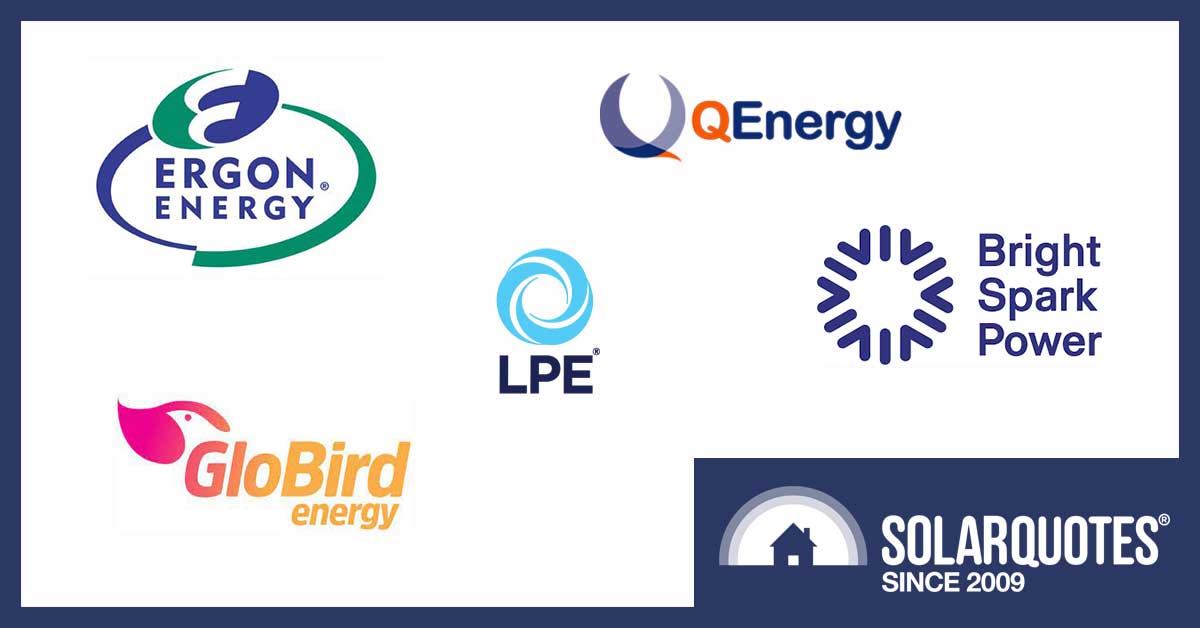
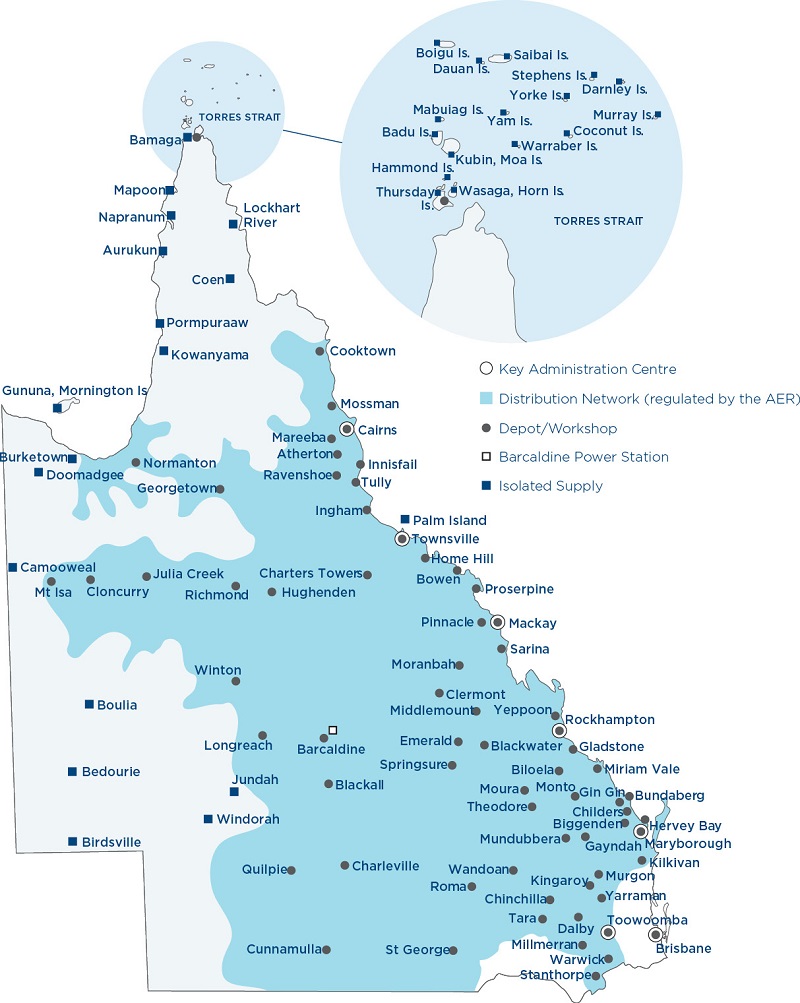

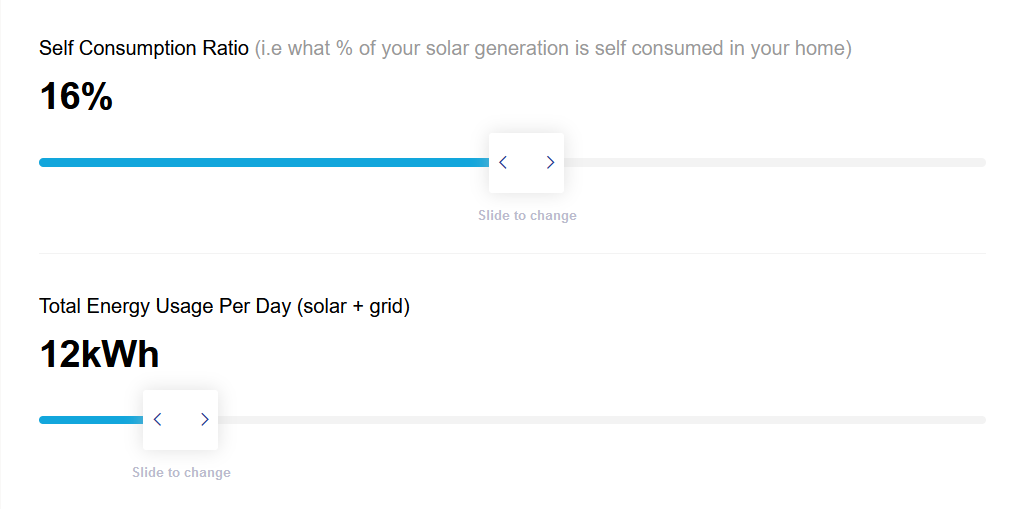
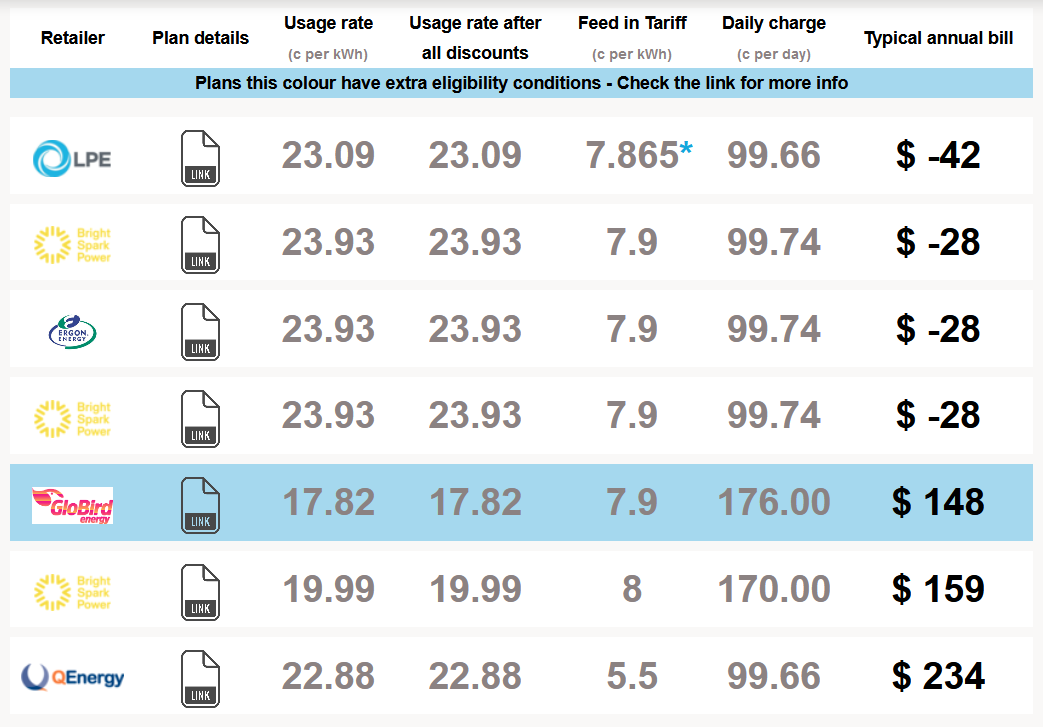



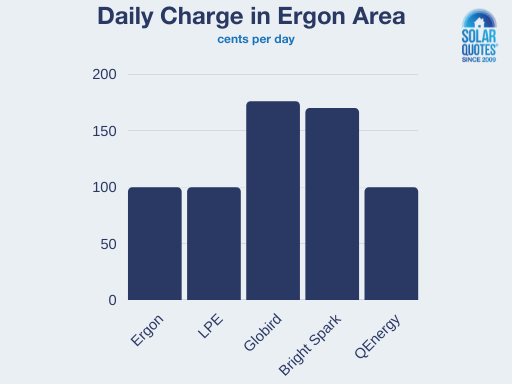
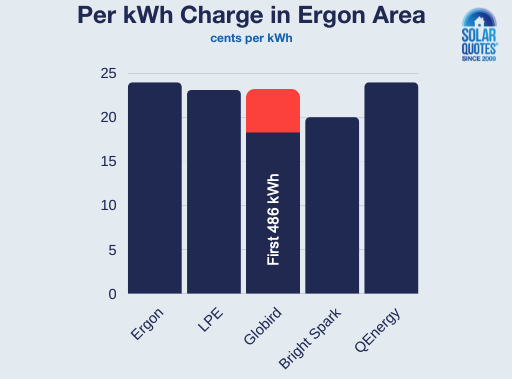

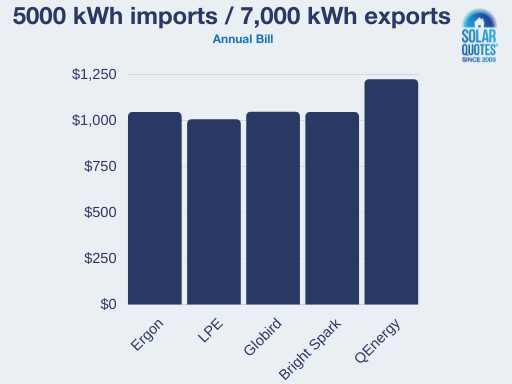
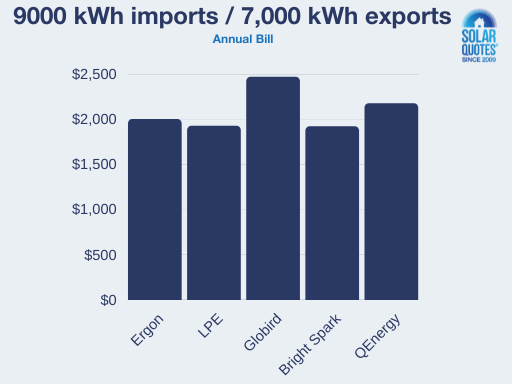
 RSS - Posts
RSS - Posts



As a regional Queenslander I say thank you for this valuable article. As a regional Qld solar home that exports more energy than we use, I will certainly be doing the sums to calculate which is the best provider for us. Huge thanks.
Thanks for the kind words.
Does it matter to have your meter read each month or every three months. My wife and I have a 6 kw solar system and we are in the lowest category as far as usage and yet we seem to have a monthly bill of $50. From memory we produced some 577 kw hrs and used some 155kw per month. Ergon is receiving over 400kw hrs extra while our usage means we still pay them quite a lot. I live in Hervey Bay area.
Whether you pay your bills monthly or quarterly makes no difference to the total amount you pay for electricity. But if you pay monthly and don’t have a smart meter those bills will often those be estimates based on past use because they usually don’t check meters that often. But when you do get your meter read your next bill will be adjusted to make sure what you pay is the correct total.
Hi, my wife and I are in Toowoomba and we do not get a choice, it’s Ergon or nothing. We have a 6.6kw system that we mainly use to heat a swim spa so there is not much going into the grid in the winter. Can you explain why we get such a low feed in tariff as Ergon then on sell the power at around 15 cents profit to them? The feed in price would be a lot fairer at around 15 cents per Kw and also encourage more people to have a solar system. We in Qld seem to be going backwards not forwards. Do solar farms get around the same feed in tariff as l don’t think it would be viable for them if they did.
LPE has told me they are available in Toowoomba. If this is correct, you can save a small amount on your bills compared to Ergon. If LPE tells you they’re not available in Toowoomba let me know and I’ll update the article.
This article goes into why solar feed-in tariffs are so much lower than the price of grid electricity:
https://www.solarquotes.com.au/blog/solar-electricity-bill-breakdown/
Solar farms only receive the wholesale price of electricity and Large scale Generation Certificates (LGCs). The average wholesale price during the day is not high and LGCs may be under 1 cent per kilowatt-hour in a couple of years.
Could do with a update or new article iv just been looking around after finding this page and i can confirm apart from globird there all gone either having left QLD or shut-down with globird I haven’t so far confirmed if they actually still support us as there tariff page just redirects to a government comparison site and there own system to check availability says you have to contact them about availability directly if you need a default offer service instead of a market offer.